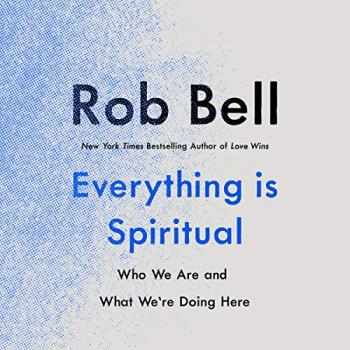 By Rick Rice
By Rick Rice
[This post is part of a Roundtable conversation on the new book, Catholicism: A Journey to the Heart of the Faith, by Father Robert Barron, hosted at the Patheos Book Club.]
Catholicism is like a sweater.
I first heard my priest say that in RCIA a few weeks ago. The context was Catholicism’s status as the original Church and how the many flavors of Christianity that exist today are each derived from the Church Christ and His apostles founded. Father Mike said simply, if Catholicism is a sweater, the 30,000+ denominations in play currently are merely threads pulled from that same sweater.
For me, the analogy doesn’t just end there.
For most of my life, I’ve not taken a particular liking to sweaters.
I wore sweaters as a kid because my parents made me. I wore them because I felt obligated to when they were given as gifts. Since cold didn’t bother me as a youngster, I’d simply found little use for sweaters. As I’ve grown older and less enamored with chilly weather, I’ve gained enough wisdom to acknowledge the worth of a decent one, though.
I was baptized as an infant in the Catholic Church and raised in it until shortly after my First Communion. I attended somewhat regularly to that point (my mother would make me go) but not long after, I increasingly found Catholicism to be “itchy” and when I became of age, I simply walked away. I regret that now – immensely. Over the 40 years I spent away, discovering the coldness of life, I could have made good use of a solid and comforting sweater.
A couple of months ago, I was asked by Father Mike to assist in leading this year’s RCIA class, — a task that will help to feed my hunger to learn more about my newly re-embraced faith, and one that will be substantially aided by the release of Father Robert Barron’s new video series (and accompanying book), Catholicism, A Journey to the Heart of the Faith.
The book is compiled from scripts used in the video series and I recommend it highly, for those wanting to find out more about the faith particularly, but also those who have been Catholic for most of their lives, and know that they don’t know much.
The book is certainly intellectually engaging; check out this Barron passage from the fourth chapter — describing what the Assumption of Mary demonstrates:
When we speak of the Assumption of the Blessed Mother’s body, we are not envisioning a journey through space, as though Mary moved up into the sky. The ‘heavens’ are a rich and consistent biblical symbol for the transcendent, for a manner of existence that lies beyond our familiar dimensions for space and time. The Assumption of Mary means that the blessed Mother was ‘translated,’ in the totality of her being, from this dimensional system to the higher one for which we use the symbolically evocative term ‘heaven.’ Perhaps a comparison would help here. Think of a square, a circle, and a triangle plotted out on a two-dimensional plane. Now imagine those figures elevated through the introduction of a third dimension into a cube, a sphere, and a pyramid. They have not so much lost their former identities as found them heightened deepened, and perfected. What if there were a conscious subject who lived exclusively in a two dimensional world? He would know only squares, circles, triangles and so on, and if you spoke to him of cubes, spheres and pyramids, he would find your language utterly impenetrable, so much nonsense. Heaven is a symbol for a higher dimensional system that contains the dimensions with which we are familiar but that also elevates them and situates them in a richer context. Mary, who exists now in this other world, is not so much somewhere else as somehow else, and this helps to explain why we can speak of her, especially in her heavenly state, interceding, helping us and praying for us. Again, to people who have known only this world, such a concept will necessarily be opaque, even ridiculous. The doctrine of Mary’s Assumption both whets our appetite for this higher world and teases our minds in the consideration of it.
As someone who not long ago (and completely from ignorance) found Marian Catholic doctrine distasteful and, dare I say ‘itchy,’ I found Father Barron’s explanation to be easily understood and embraceable. But he is this accessible on everything, not just Mariology. He has a knack for making simple and believable that which might initially seem to be complex and incredible. The chapter excerpted here is but one example.
The book is instructive, solid and comforting, without being too heavy. I urge all Catholics to pick up a copy, to watch for the series or purchase the video set or all of the above. You will not be disappointed.
Father Barron might just make you long for that sweater you’ve been spurning.
You’ll have to trust me on this.
Rick Rice blogs at Brutally Honest. He last contributed to the Book Club on Jesus and the Jewish Roots of the Eucharist. Rick also contributed to a blogger symposium during Patheos’ Future of Catholicism week in a 2010 Summer Series.
For more conversation and resources on the new book Catholicism, visit the Patheos Book Club.












